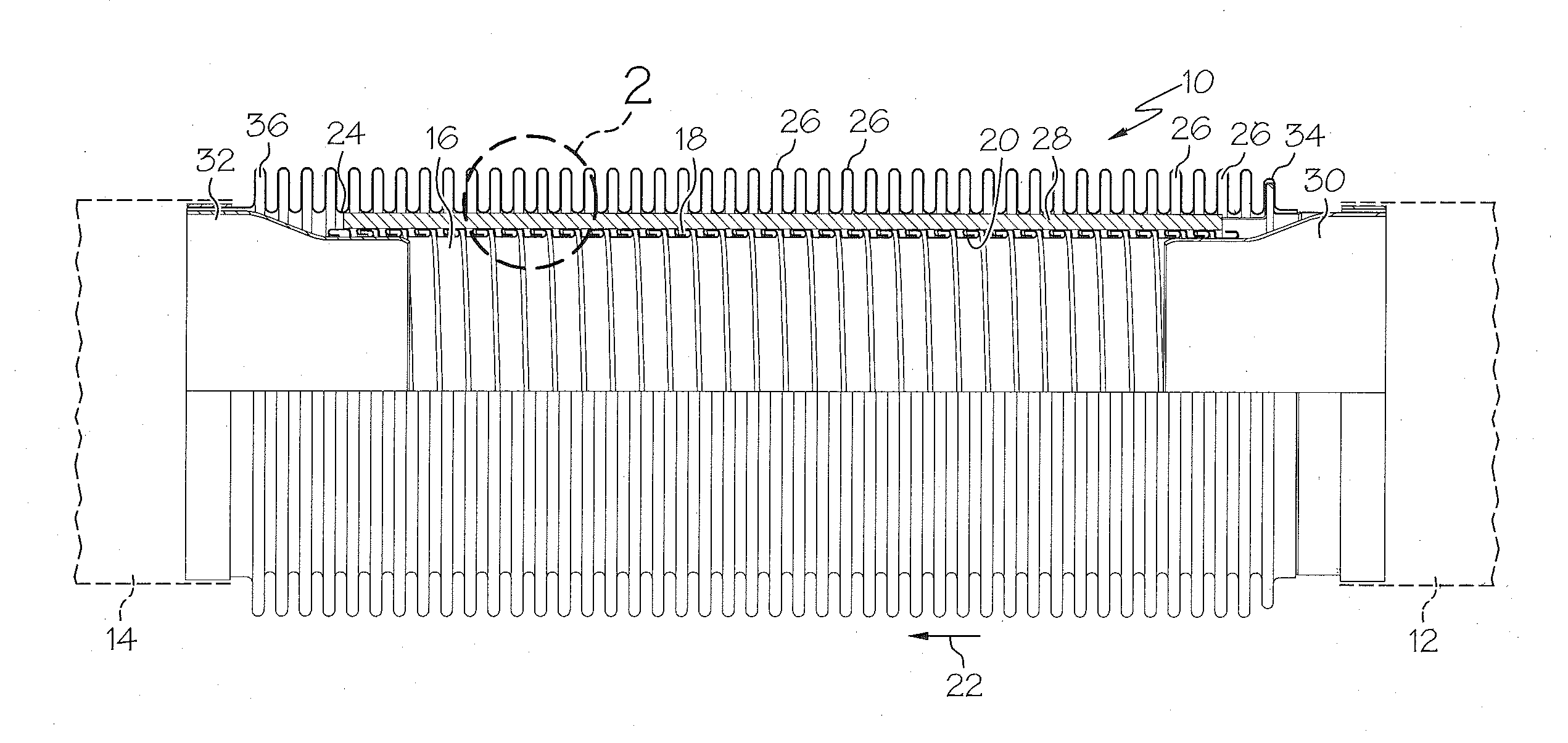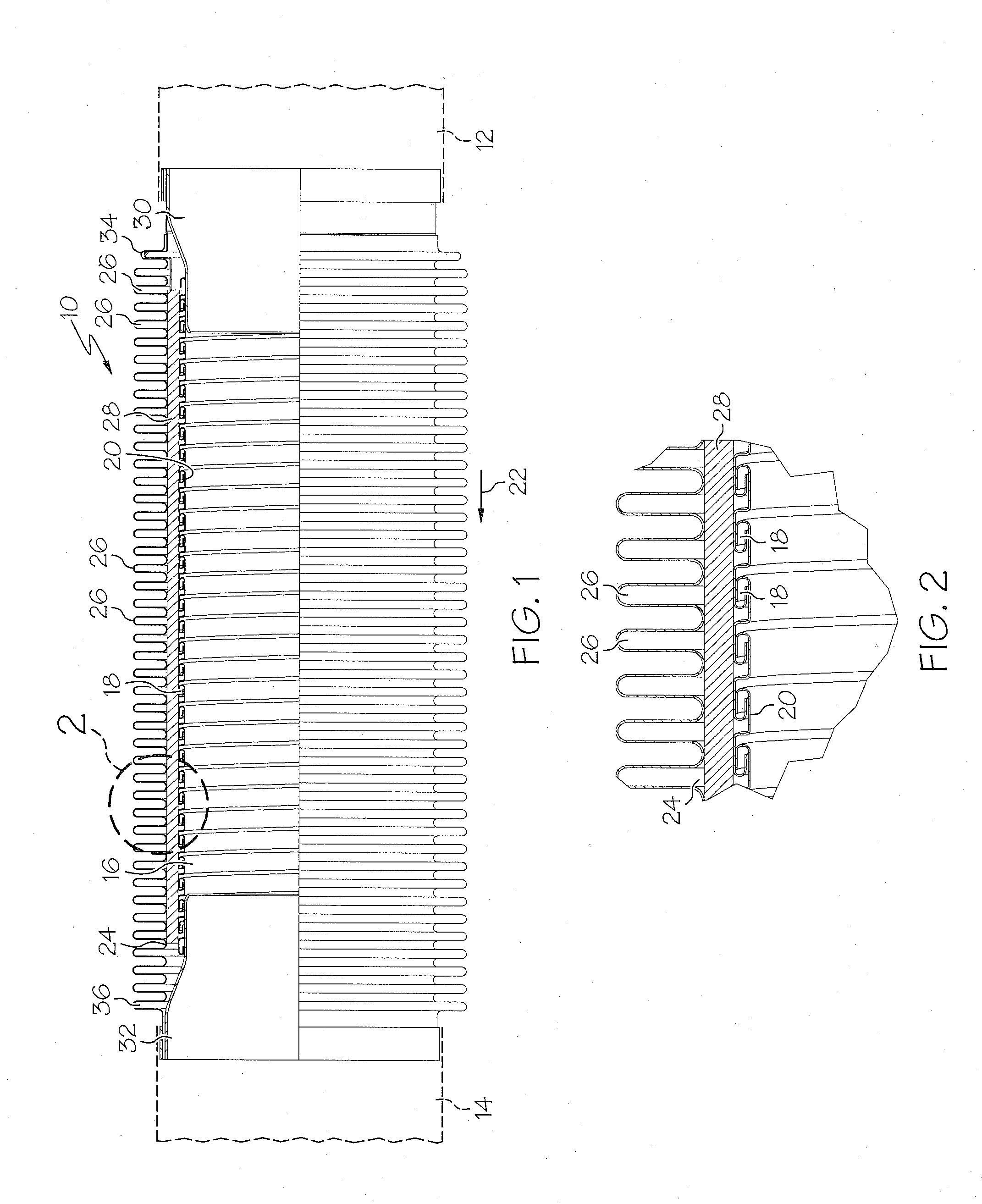Exhaust system conduit with thermal/noise insulation
a technology of exhaust system and conduit, applied in the direction of adjustable joints, machines/engines, mechanical equipment, etc., can solve the problems of unfavorable heat stress, vibration and other movement, and the prior art exhaust system of this type is not completely free of problems, so as to reduce vibration, resist heat transmission, and suppress noise transmission
- Summary
- Abstract
- Description
- Claims
- Application Information
AI Technical Summary
Benefits of technology
Problems solved by technology
Method used
Image
Examples
second embodiment
[0027]Referring now to FIG. 3, numeral 110 generally identifies a conduit constructed according to the invention. The conduit 110 is used to connect a pair of pipes 112 and 114 which may be part of a vehicular exhaust system or another type of pipe system.
[0028]The conduit 110 has an inside liner 116 which may be a spirally wound strip 118 interconnected at its edges in the manner described previously for conduit 16. The liner 116 provides a cylindrical bore 120 aligned with the bores of pipes 112 and 114 to accommodate the flow of materials such as hot exhaust gases from pipe 112 to pipe 114.
[0029]An outer portion of the conduit 110 is provided by a bellows 124 having a plurality of corrugations 126 on its outside surface. The bellows 124 may be constructed generally in the same manner as bellows 24.
[0030]An insulation blanket 128 is enclosed within conduit 110 between the inside liner 116 and bellows 124. The blanket 128 serves the same function as blanket 28 and may be constructe...
third embodiment
[0035]Referring now to FIG. 5, numeral 210 generally identifies a conduit constructed according to the invention. The conduit 210 may be constructed in the manner described previously for conduit 110. However, as illustrated in FIGS. 5 and 6, an insulation blanket 134 is located between the bellows 124 and the cover 129, rather than between the inside liner 116 and bellows 124. The blanket 134 generally serves the same function as blankets 28 and 128 and may be constructed of the same materials and in a similar configuration. Like conduit 110, one or both of the ends 130 and 132 of conduit 210 may be constructed to form a torsional or non-torsional joint.
fourth embodiment
[0036]Referring now to FIG. 7, numeral 310 generally identifies a conduit constructed according to the invention. The conduit 310 may be constructed in the manner described previously for conduits 110 and 210. However, as illustrated in FIGS. 7 and 8, the conduit may include two separate insulation blankets 136 and 138. As shown, blanket 136 is sandwiched between the inside liner 116 and the bellows 124, much like blankets 28 and 128 in conduits 10 and 110, respectively. Blanket 138 is located between the bellows 124 and the cover 129, much like blanket 134 in conduit 210. Blankets 136 and 138 generally serve the same functions as blankets 128 and 134, respectively, and may be constructed of the same materials and in similar configurations. Like conduit 110, one or both of the ends 130 and 132 of conduit 310 may be constructed to form a torsional or non-torsional joint.
PUM
 Login to View More
Login to View More Abstract
Description
Claims
Application Information
 Login to View More
Login to View More - R&D
- Intellectual Property
- Life Sciences
- Materials
- Tech Scout
- Unparalleled Data Quality
- Higher Quality Content
- 60% Fewer Hallucinations
Browse by: Latest US Patents, China's latest patents, Technical Efficacy Thesaurus, Application Domain, Technology Topic, Popular Technical Reports.
© 2025 PatSnap. All rights reserved.Legal|Privacy policy|Modern Slavery Act Transparency Statement|Sitemap|About US| Contact US: help@patsnap.com



